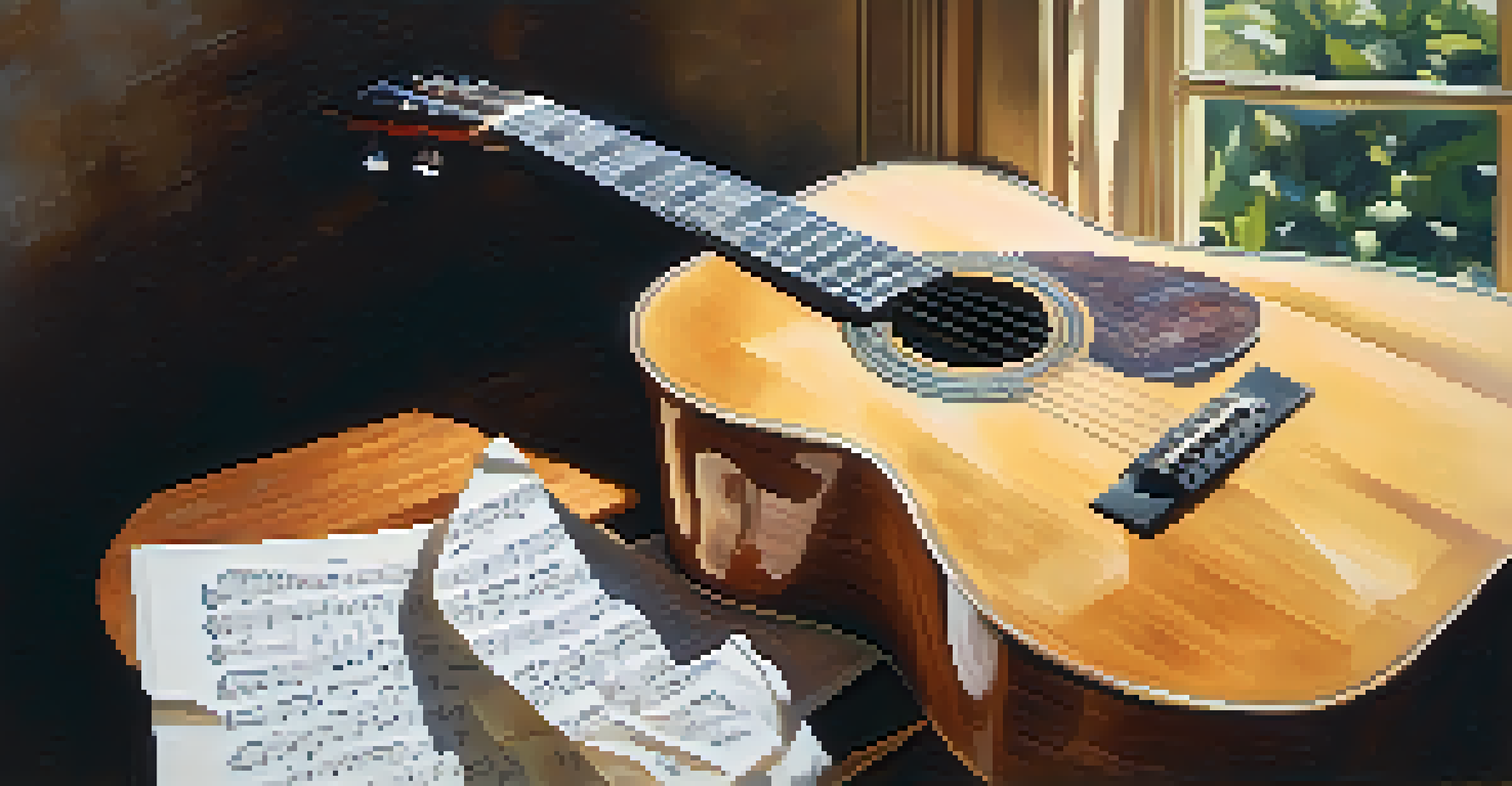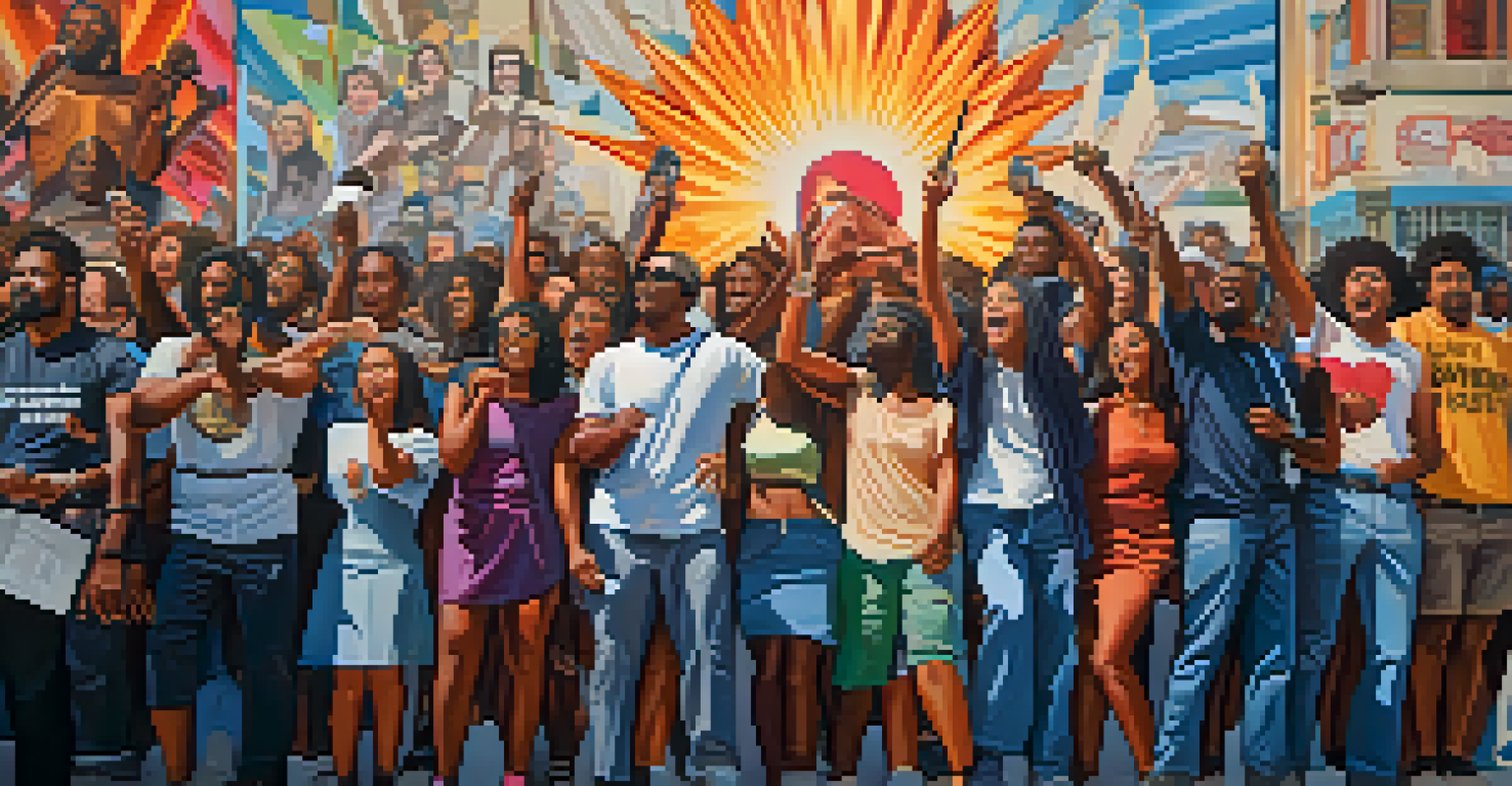Music and the Anti-War Movement: A Harmonious Resistance

The Soundtrack of Dissent: Music's Role in Activism
Throughout history, music has served as a powerful tool for resistance. During tumultuous times, artists have harnessed their creativity to convey messages of peace and protest. Songs become the anthems that unite people, giving voice to their struggles and aspirations for a better world.
Music can change the world because it can change people.
From folk ballads to rock anthems, various genres have played pivotal roles in movements for social change. For instance, during the Vietnam War, songs like 'Fortunate Son' by Creedence Clearwater Revival captured the disillusionment of a generation. This musical backdrop not only resonated with individuals but also galvanized crowds to take action.
The emotional weight of music allows it to transcend boundaries, making it an ideal medium for rallying support. When people gather around a shared song, they forge connections that deepen their commitment to the cause. Music can make resistance feel less like a solitary struggle and more like a collective journey.
Iconic Songs That Shaped the Anti-War Movement
Certain songs have become synonymous with the anti-war movement, etching their messages into the fabric of history. Bob Dylan's 'Blowin' in the Wind' is a poignant example of how music can pose profound questions about peace and justice. Its simple yet powerful lyrics invite listeners to reflect on the human cost of conflict.

Another notable anthem, 'Give Peace a Chance' by John Lennon, emerged as a rallying cry for peace in the 1960s. Its repetitive, chant-like structure encouraged mass sing-alongs, creating a sense of unity among protesters. This song exemplifies how music can transform a protest into a celebration of hope and solidarity.
Music Unites for Social Change
Throughout history, music has been a powerful tool for activism, bringing people together to express their struggles and hopes for a better world.
As these songs played on radios and at demonstrations, they inspired countless individuals to join the movement. Their ability to articulate feelings of frustration and desire for change made them integral to the anti-war narrative. In many ways, these iconic tracks became the heartbeat of a generation committed to peace.
The Power of Lyrics: Messages That Resonate
The lyrics of protest songs often serve as poignant commentaries on societal issues. They highlight the injustices faced by individuals, prompting listeners to think critically about war and its implications. For example, 'War' by Edwin Starr famously declares, 'War, huh, yeah, what is it good for? Absolutely nothing!' This unfiltered critique resonates across generations.
The power of music can make a change in the world, that’s why I use my voice to speak for those who have no voice.
Moreover, the emotional pull of certain lines can inspire listeners to take action. When a song articulates feelings of despair or anger, it can validate the emotions of those who feel marginalized. This validation fosters a sense of community among listeners, reinforcing their resolve to work towards change.
As the anti-war movement evolved, so did the themes found in music. Artists began to address not just the immediate consequences of war, but also broader issues like civil rights and social justice. This expansion of themes created a more inclusive movement that resonated with a wider audience, ensuring that music remained a vital part of the conversation.
Artists as Activists: The Role of Musicians
Many musicians have stepped beyond their roles as entertainers to become passionate activists. Their platform allows them to reach large audiences, making them influential voices in the anti-war movement. Artists like Joan Baez and Bruce Springsteen have used their fame to draw attention to pressing issues, mobilizing fans to join the cause.
The intertwining of music and activism can also be seen in benefit concerts, which raise funds and awareness for various causes. Events like Live Aid not only showcased musical talent but also highlighted the urgent need for humanitarian assistance. These gatherings reflect the power of music to bring people together for a common purpose.
Iconic Anthems of Resistance
Songs like 'Blowin' in the Wind' and 'Give Peace a Chance' have become synonymous with the anti-war movement, inspiring collective action and unity among protesters.
Moreover, the commitment of these artists to their causes often inspires fans to engage in activism themselves. When musicians advocate for peace, their messages can resonate deeply with listeners, prompting them to participate in protests or support organizations. This creates a cycle where music fuels activism, and activism, in turn, inspires more music.
The Impact of Music Festivals on the Anti-War Movement
Music festivals have historically served as vital spaces for anti-war expressions. Events like Woodstock in 1969 became symbols of peace and unity, drawing thousands of attendees who shared a common vision. The festival atmosphere fostered a sense of belonging, reinforcing the idea that collective action could lead to meaningful change.
During these festivals, performances often included protest songs that echoed the sentiments of the attendees. The communal experience of singing together amplified the emotional impact of the music. It created an environment where individuals felt empowered to voice their dissent and advocate for peace.
The legacy of these festivals continues to influence modern activism, illustrating how music can transform social gatherings into powerful movements. Today's festivals often include panels and discussions on social issues, keeping the spirit of activism alive. This evolution shows that the connection between music and social change remains strong, even decades later.
Digital Age: Music's New Role in Activism
With the rise of digital platforms, music has found new avenues for promoting anti-war messages. Social media allows artists to connect directly with fans, sharing their thoughts and music in real time. This immediate access has transformed how messages of resistance spread, making them more dynamic and far-reaching.
Streaming platforms have also democratized music distribution, allowing a diverse array of voices to emerge. Independent artists can share their protest songs without the backing of major labels, ensuring that a wide range of perspectives are heard. This shift enriches the anti-war narrative with fresh ideas and innovative sounds.
Digital Era: New Activism Avenue
The rise of digital platforms has transformed how music promotes anti-war messages, allowing diverse voices to emerge and spread messages of resistance more dynamically.
Moreover, the ability to create and share music videos online means that powerful visuals can accompany these messages. Artists can craft compelling narratives that resonate deeply with audiences, amplifying the emotional weight of their music. In this way, the digital age has not only preserved the tradition of musical activism but has also expanded its reach.
Music as a Lasting Legacy of Resistance
The relationship between music and the anti-war movement creates a lasting legacy that continues to inspire future generations. Songs from past movements serve as reminders of the struggles faced and the victories achieved. They highlight the power of collective action and the role that art plays in shaping societal change.
As new conflicts arise, artists continue to draw on this legacy to craft relevant protest music. The themes of peace, justice, and unity remain as essential today as they were during earlier movements. This continuity ensures that music will always be a vital part of the conversation surrounding war and resistance.

Ultimately, the blend of music and activism illustrates that art can be a force for good. It not only reflects societal issues but also inspires individuals to envision and work towards a better future. As history shows, when people come together in song, they can create a harmonious resistance that echoes through time.